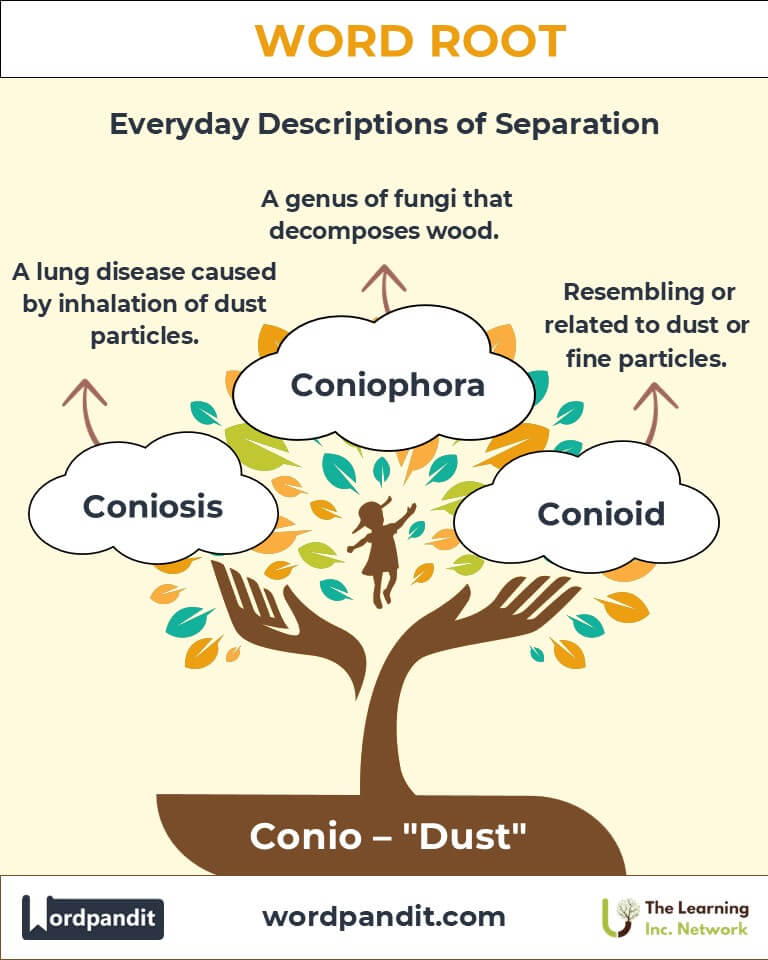Conio: The Root of Dust in Language and Science
Unveil the significance of the root "Conio," derived from Greek, meaning "dust." From health-related terms like "coniosis" to biological references such as "conidium," this root speaks to the microscopic particles that play significant roles in our environment and health.

Table of Contents
- Introduction: The Essence of Conio
- Etymology and Historical Journey
- Mnemonic: Unlocking the Power of Conio
- Common Conio-Related Terms
- Conio Through Time
- Conio in Specialized Fields
- Illustrative Story: Conio in Action
- Cultural Significance of Conio
- The Conio Family Tree
- FAQs About the Conio Word Root
- Test Your Knowledge: Conio Mastery Quiz
- Conclusion: The Living Legacy of Conio
Introduction: The Essence of Conio
Picture a cloud of dust dancing in a sunbeam or the invisible particles that travel through the air. The root Conio (pronounced: koh-nee-oh) embodies the idea of "dust," originating from the Greek word konis. Found in biological, environmental, and medical terminology, it symbolizes the pervasive yet unseen particles that shape both life and health.

Etymology and Historical Journey
The word root Conio traces back to the Greek term konis (dust). Ancient Greeks used konis to describe fine particles, whether in nature or as metaphors for insignificance. Over time, this root entered scientific lexicons, influencing terms in biology (e.g., fungal spores) and medicine (e.g., diseases caused by inhaling dust).
In the Industrial Revolution, words like coniosis gained prominence as dust-related illnesses affected workers exposed to hazardous environments. In modern science, conidium reflects its legacy in describing microscopic fungal spores.
Mnemonic: Unlocking the Power of Conio
Imagine a dusty bookshelf where each particle represents a word derived from Conio. To make it memorable:
“Conio captures the unseen: tiny dust, big impact!”
Common Conio-Related Terms
- Coniosis (koh-nee-oh-sis): A disease caused by inhalation of dust particles, often in industrial settings.
Example: "Silicosis is a type of coniosis common among miners." - Conidium (koh-nid-ee-um): A spore produced by fungi, essential for their reproduction.
Example: "The mold spread rapidly by releasing conidia into the air." - Coniophora (koh-nee-off-or-ah): A genus of fungi known for decomposing wood.
Example: "Coniophora fungi contribute to the natural recycling of forest materials." - Conioid (koh-nee-oid): Resembling or related to dust or fine particles.
Example: "The conioid structure of the powder made it challenging to handle." - Coniothyrium (koh-nee-oh-thir-ee-um): A type of fungus affecting plants, causing diseases.
Example: "Coniothyrium fungi were identified as the cause of the crop blight."
Conio Through Time
- Historical Use: Ancient Greek writers used konis to symbolize transience, as dust was seen as ephemeral and insignificant.
- Industrial Shift: In the 19th century, medical terms like pneumoconiosis emerged to describe respiratory diseases caused by occupational dust exposure.
- Modern Usage: Biological advancements brought conidium into common use, reflecting its importance in fungal reproduction and ecological cycles.
Conio in Specialized Fields
- Medicine: Coniosis describes occupational lung diseases like silicosis and asbestosis.
- Biology: Conidium is a reproductive spore in fungi, crucial for their propagation.
- Ecology: Coniophora fungi aid in decomposing organic matter, vital for nutrient recycling in ecosystems.
- Engineering: Conioid materials are used in studying particulate structures and designing air filters.
Illustrative Story: Conio in Action
Dr. Marcus, a mycologist, studied fungal spores to control agricultural blights. During a fungal outbreak, he analyzed conidia under a microscope, uncovering their dispersal mechanism. Meanwhile, an industrial hygienist tackled a case of silicosis in workers exposed to fine dust. Together, their work highlighted the dual role of Conio: a source of life and a cause of disease.
Cultural Significance of Conio
Dust has symbolic meanings in many cultures, representing transience, mortality, and transformation. In literature, “to return to dust” evokes the cycle of life and death. Scientifically, Conio captures humanity's struggle to understand and manage the microscopic forces shaping our world.

The Conio Family Tree
- Pulver- (Latin: dust): Pulverize: To reduce to fine particles.
- Spor- (Greek: seed): Spore: A reproductive unit in fungi and plants.
- Particul- (Latin: small particle): Particulate: Microscopic solid or liquid matter.
FAQs About the Conio Word Root
Q: What does "conio" mean?
A: "Conio" originates from the Greek word konis, meaning "dust." It is commonly used in scientific and medical terminology to describe conditions, particles, or phenomena related to dust. This root appears in words like "coniosis" (a lung disease caused by dust inhalation) and "conidium" (a spore resembling dust).
Q: What is coniosis, and who is at risk?
A: Coniosis is a medical condition caused by prolonged inhalation of dust particles, often leading to lung damage. People working in mining, construction, or factories, where exposure to dust is frequent, are at higher risk. Examples include silicosis (caused by inhaling silica) and asbestosis (caused by asbestos exposure). Proper ventilation and protective gear help reduce the risk.
Q: What is a conidium, and why is it significant?
A: A conidium is a spore produced asexually by fungi. It is important in mycology because conidia serve as a means of reproduction and dispersal for fungi. These dust-like spores are often carried by air, enabling fungi to spread and colonize new environments, sometimes causing allergies or infections in humans.
Q: How does the study of "conio" relate to environmental science?
A: In environmental science, "conio" appears in contexts such as air quality monitoring and the study of airborne particles, including fungal spores like conidia. Dust and airborne pollutants have significant effects on health, ecosystems, and climate, making the study of "conio" essential for understanding and mitigating these impacts.
Q: What are common occupations at risk for coniosis?
A: Workers in industries like mining, construction, quarrying, and manufacturing face significant risks of developing coniosis. These jobs often involve prolonged exposure to dust containing silica, coal, or asbestos. Preventative measures, such as using protective equipment and enforcing safety regulations, are crucial.
Q: What are conidiophores, and where are they found?
A: Conidiophores are specialized fungal structures that produce conidia (asexual spores). They are found in various fungi, including those in the genera Aspergillus and Penicillium. Conidiophores play a critical role in fungal reproduction and dispersal, often appearing as fine, dust-like growths on surfaces.
Q: How can dust-related diseases like coniosis be prevented?
A: Preventing coniosis involves reducing exposure to harmful dust particles through measures like:
- Wearing masks or respirators.
- Improving workplace ventilation.
- Using dust suppression systems (e.g., water sprays).
- Regular health checkups for early detection of lung damage.
Test Your Knowledge: Conio Mastery Quiz
1. What does the root "conio" signify?
2. What is a conidium?
3. Which field primarily studies coniosis?
4. What does "conidiophore" produce?
5. How can coniosis be prevented?

Conclusion: The Living Legacy of Conio
The root Conio highlights the invisible yet impactful world of dust and fine particles. From its role in fungal biology to its implications in human health, Conio connects the microscopic to the macroscopic, revealing the unseen threads that bind ecosystems and societies. By understanding Conio, we gain insight into the challenges and marvels of our particulate world.











